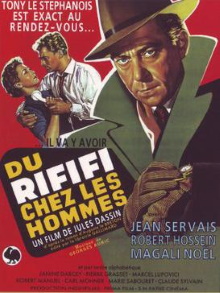This first came to my attention when it was featured in an episode of The Americans but of course we’ve already Night and the City before this. This one is now known as one of the greatest heist films of all time, featuring a heist scene so detailed and realistic that it was copied by real criminals to perform real crimes. I also didn’t realize until afterwards that director Jules Dassin was in this as the Italian safecracker. Unfortunately while the heist scene is indeed amazing, the extended denouement afterwards is nothing special.
Tony, nicknamed Le Stéphanois, is an experienced jewel thief who has just been released from prison. His friend Jo with another accomplice Mario suggest a simple theft from the display window of a jeweler’s shop but he declines. He changes his mind after he sees his former girlfriend with another gangster who runs a nightclub. He even wants to aim bigger by targeting the safe instead and they recruit an Italian safecracker named César for the job. Their planning and rehearsal for the heist is elaborate as they research the alarm system installed in the shop and figure out ways to defeat it. Thanks to their extensive preparations, the heist is of course a great success, but Mario is unable to resist pocketing a ring to give to the nightclub singer he favors. Naturally this proves to be their undoing.
There are some interesting stylistic touches in this film such as how the collaborators appear to have nicknames indicating where they come from and how the main character Tony affects an esthetic of a private detective of the period. I think this is partly due to the source material, a novel with strong racist themes in which the ethnicities of the different gangs mattered a great deal. Dassin wisely decided to throw all that out. The production was also very low budget so they had to shoot on the streets of Paris instead of in a studio. It’s all for the better however as the photography looks great and gives you a good sense of the place as well as the kind of people who operated in the Parisian underworld. It does feel very much like an American film with its straightforward heist plot albeit one that is set in Paris.
The heist scene of course the highlight and the only reason why this film is remembered. It shows every step of the process beginning with stealing a car to use for the job and has them take elaborate precautions to prevent detection, such as catching the debris that they generate. There’s no music and no dialogue at all during the heist which furthers the impression of them being a well practiced professional team. It’s no wonder this was used as a reference by real criminals. Even if the specific methods are obsolete or inappropriate, the methodology that they employ to cover all the bases and test what works would be valuable. The scene is so good that everything that takes place afterwards is such a letdown in comparison. I get the point: they function like a well-oiled machine while on the job but they are still vulnerable to the common foibles of humanity once off it. But it’s kind of a trite point to make and it’s disappointing to watch the members of the team, except Tony, be so easily pushed around by other gangsters in their civilian lives.
Anyway one solid scene, no matter how amazing it is, isn’t quite enough for me to call this a great film but I did also enjoy the shots of the streets of Paris in this. It’s easy to see however why this was so influential and its legacy lives on in the heist films of modern cinema.
